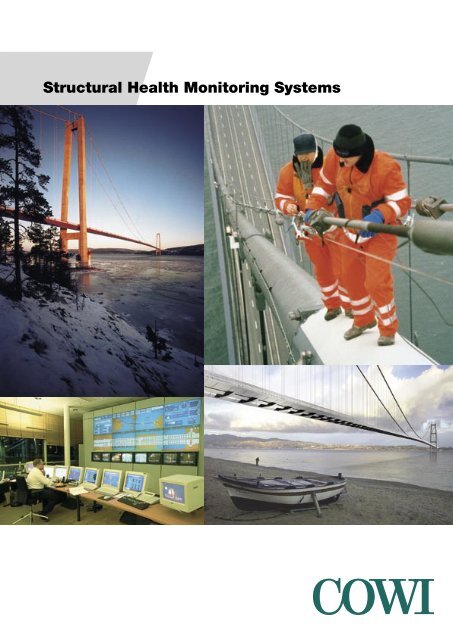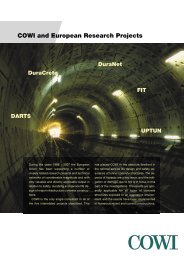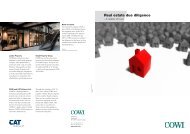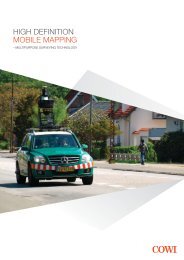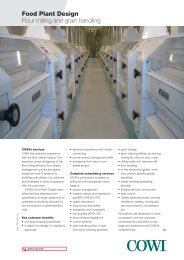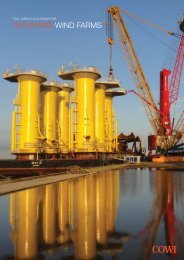Structural Health Monitoring Systems - Cowi
Structural Health Monitoring Systems - Cowi
Structural Health Monitoring Systems - Cowi
Create successful ePaper yourself
Turn your PDF publications into a flip-book with our unique Google optimized e-Paper software.
<strong>Structural</strong> <strong>Health</strong> <strong>Monitoring</strong> <strong>Systems</strong>
COWI Expertise<br />
COWI is an international consultant<br />
that holds a market leading position<br />
in bridge, tunnel and marine engineering.<br />
COWI possesses a wide<br />
range of expertise within core<br />
disciplines related to structural<br />
monitoring systems:<br />
• Planning and design of structural<br />
health monitoring systems<br />
• Data acquisition<br />
• Advanced data transmission<br />
• Data analysis<br />
• Data presentation<br />
• <strong>Structural</strong> modelling and analysis<br />
• Calibration of FEM and life time<br />
models<br />
• Integration of structural monitoring<br />
systems with bridge maintenance<br />
planning systems<br />
• Establishment of reporting<br />
routines and contingency plans<br />
engineering area. Numerous and<br />
rather sophisticated systems have<br />
been established.<br />
It is the experience of COWI that<br />
an early and thorough discussion<br />
with the future stakeholder(s) in the<br />
<strong>Structural</strong> <strong>Monitoring</strong> programme<br />
on the possible objectives and the<br />
various system possibilities that are<br />
available, paves the way for an<br />
efficient and direct path to design,<br />
procurement, installation and operation<br />
of a sufficient and cost efficient<br />
monitoring system.<br />
COWI Services<br />
Examples of COWI’s services from<br />
the various application areas of<br />
<strong>Structural</strong> <strong>Monitoring</strong> <strong>Systems</strong> are<br />
presented in the following pages.<br />
COWI’s ISO 9001 certifi cation<br />
covers structural monitoring.<br />
<strong>Structural</strong> <strong>Monitoring</strong><br />
<strong>Structural</strong> <strong>Monitoring</strong> is basically<br />
an activity where actual data related<br />
to civil structures are observed /<br />
measured and registered. This has<br />
been performed through all times by<br />
responsible designers, contractors<br />
and owners with almost identical<br />
objectives - to check that the<br />
structures behave as intended.<br />
Historically the activity has required<br />
specialists, has been time consuming<br />
and hence costly.<br />
This situation has been dramatically<br />
changed by the enormous<br />
development within information<br />
technology in the last two decades.<br />
<strong>Structural</strong> <strong>Monitoring</strong> has thus<br />
emerged as a distinct technical<br />
discipline as the new technologies<br />
have been introduced in the civil<br />
COWI made the conceptual design for the<br />
<strong>Structural</strong> <strong>Monitoring</strong> System for the<br />
Normandy Cable Stay Bridge, France.<br />
Calibration of monitoring<br />
system by measurement of<br />
suspension bridge hanger<br />
force by the frequency identifi<br />
cation method.
3<br />
The Stonecuttersrs Bridge in Hong Kong<br />
will be equipped with an advanced Wind<br />
and <strong>Structural</strong> <strong>Health</strong> <strong>Monitoring</strong> System<br />
designed by COWI.<br />
Actors/Stakeholders<br />
The planning of structural monitoring<br />
systems must take into account<br />
the interests of the different actors<br />
in a bridge project. The design-,<br />
construction- and operation phases<br />
must be considered according to<br />
these interests. The objectives,<br />
requirements and deliveries deciding<br />
the structure of the monitoring<br />
system may change depending on<br />
whom and what phase the system is<br />
supposed to support.<br />
The typical groups involved<br />
during the construction and service<br />
lifetime of a bridge structure are as<br />
follows<br />
• Owner<br />
• Designer<br />
• Contractor<br />
• Operator<br />
• Researchers/Universities<br />
Based on the large experience of<br />
COWI in designing major bridges<br />
world wide the structural monitoring<br />
objectives for these actors are in<br />
general known by COWI.<br />
<strong>Structural</strong> <strong>Monitoring</strong> System<br />
Objectives<br />
The purpose of <strong>Structural</strong> <strong>Monitoring</strong><br />
is the examination and location<br />
of structural condition and possible<br />
damage in the structural elements of<br />
a structure set into the context of<br />
user objectives, requirements and<br />
deliveries.<br />
The initial system analysis shall<br />
cover and answer the following<br />
points according to which user types<br />
and phases in the service lifetime the<br />
system shall support;<br />
• Objective<br />
• Requirements<br />
• Basis<br />
• Scope<br />
• Interfaces<br />
• Deliveries<br />
<strong>Structural</strong> <strong>Monitoring</strong> System<br />
Activities<br />
Technically the developed structural<br />
monitoring system will consists of<br />
three major parts to meet this way<br />
to organise the activities:<br />
• Sensing modules placed on the<br />
structure. These modules consist<br />
of various types of sensors<br />
depending on the nature of the<br />
structure. This also includes a<br />
signal collection and conditioning<br />
unit.<br />
• A data communication system for<br />
the transfer of the collected data<br />
to a remote computer.<br />
• A database application, which<br />
collects, stores and processes the<br />
sensor data in real time, in order<br />
to provide an evaluation of the<br />
condition of the structure based<br />
on the above mentioned application<br />
areas<br />
For all bridge structures where the<br />
need for a structural monitoring<br />
system is considered there must be<br />
carried out an initial analyse to map<br />
the deliveries the bridge operator<br />
needs for his particular bridge.<br />
Hereby the extent of the onstructure<br />
installations and the<br />
functions of the data management<br />
and control can be established in<br />
order to secure the most reliable,<br />
easy to operate and cost efficient<br />
system to design and install.
4<br />
<strong>Structural</strong> <strong>Monitoring</strong> Decision<br />
Making Process and Objectives<br />
The objective of <strong>Structural</strong> <strong>Monitoring</strong><br />
is to provide the necessary<br />
information of the structural<br />
condition and possible damage in<br />
order to provide the documented<br />
basis for decisions concerning these<br />
matters.<br />
All structural monitoring systems<br />
regardless size operates on different<br />
levels for the management and<br />
control of acquired data. These<br />
levels can be expressed by a generic<br />
model for structural monitoring to<br />
identify strategic, analyse/planning<br />
and operational goals. Using such a<br />
model will ensure that managers on<br />
different levels of the bridge<br />
operation organisation will have the<br />
correct level of information to<br />
support there decisions.<br />
Reporting<br />
Reporting<br />
Reporting<br />
Evaluation<br />
Strategic<br />
Implementation<br />
Evaluation<br />
Analyse/<br />
Planning<br />
Implementation<br />
Evaluation<br />
Operational<br />
Implementation<br />
Generic model for the<br />
organisation of structural<br />
monitoring activities.<br />
Requirements<br />
Requirements<br />
Requirements<br />
Organisation of structural monitoring data<br />
Strategic Reports<br />
Tactical Statistical info…<br />
Operational Data<br />
acquisition Storage<br />
of raw data….<br />
Organisation of <strong>Structural</strong><br />
<strong>Monitoring</strong> Data<br />
The structural monitoring basis is<br />
the acquired data from sensors<br />
installed on the structure. In order<br />
to support the above discussed<br />
organisation of structural monitoring<br />
activities the data must be<br />
organised the same way.<br />
On the operational level there will<br />
be one or several individual data<br />
acquisition systems storing the raw<br />
data in preset formats or databases.<br />
From these raw data statistical<br />
information and sample time series<br />
selected based on the bypass of<br />
preset trigger levels will be passed<br />
on to the analysing and planning<br />
level. Only the results of the<br />
management and control performed<br />
at the analysing and planning level<br />
will be reported at the strategic<br />
level. Alarms affecting the immedial<br />
safety of the bridge will always be<br />
reported instantaneous to all<br />
affected managers in the bridge<br />
organisation.<br />
Prioritisation of <strong>Structural</strong><br />
<strong>Monitoring</strong> Deliveries<br />
Most important for the planning of<br />
a structural monitoring system is the<br />
initial analyse to map the deliveries<br />
the system user needs for his<br />
particular bridge based on the above<br />
discussed considerations to take into<br />
account.<br />
The structural components<br />
assessed to have a need for monitoring<br />
shall be listed in a prioritised list<br />
and grouped as;<br />
• Need to know information<br />
• Nice to know information<br />
• Scientific information.<br />
The list shall be discussed with the<br />
actors; structural bridge designer,<br />
the bridge operator and if a maintenance<br />
unit is planned also the<br />
designer of maintenance activities<br />
according to the actors and their<br />
interests<br />
The storage, processing and<br />
management of monitoring information<br />
shall reflect this list. The<br />
management and control of the<br />
groups shall be put into the shown<br />
generic model.
5<br />
The SuTong Bridge in China is<br />
designed with a sofi sticated structural<br />
monitoring system including all<br />
application areas of structural<br />
monitoring.<br />
Guideline for <strong>Structural</strong><br />
<strong>Monitoring</strong> System Parameters<br />
Objectives<br />
The overall aims for structural<br />
monitoring systems are to<br />
• ensure safe structures<br />
• obtain rational and economic<br />
maintenance planning<br />
• attain safe & economic operation<br />
• identify causes for unacceptable<br />
responses<br />
Application Areas<br />
Design Verification<br />
<strong>Structural</strong> monitoring systems can<br />
acquire data on loads and structural<br />
responses over long measurement<br />
periods to verify stochastic load<br />
parameters and compare them with<br />
design requirements and calculated<br />
response. Short time monitoring can<br />
include forced loading on a structure.<br />
Maintenance Planning <strong>Monitoring</strong><br />
of structures can provide<br />
quantification of degradation rates<br />
and wear which are essential to a<br />
regular updating of information on<br />
structural states. This in turn can<br />
be used in rational planning of<br />
inspection, maintenance activities<br />
and calibration of lifetime models.<br />
User Safety<br />
<strong>Structural</strong> integrity of critical<br />
elements may be crucial to the<br />
operational safety of structural<br />
systems. Continuous surveillance of<br />
such elements can provide information<br />
or alarms to intervene before<br />
severe consequences develop.<br />
Trouble Shooting<br />
Intermittent and insuffi ciently<br />
understood responses of structures<br />
and associated load parameters<br />
(often wind) can be documented<br />
through automated measuring<br />
campaigns - often of extended<br />
duration.<br />
Example on a SHMS user interface<br />
for the Neva Bridge, Russia,<br />
developed by Futertec, Finland.
6<br />
Low cost <strong>Structural</strong><br />
Evaluation <strong>Monitoring</strong><br />
System at Naini Bridge,<br />
India. Designed and<br />
supervised by COWI<br />
phase of a Bridge will provide for<br />
the detection of meteorological,<br />
seismic-tectonic, geometrical,<br />
structural data and/or other data<br />
considered being useful to build the<br />
“history” of the Work.<br />
All measurements and detections<br />
can be performed with adequate<br />
periodicity, can include information<br />
related to location, date and time of<br />
the detection, and can be recorded<br />
and made available during the<br />
construction phase and give information<br />
feedback to the bridge<br />
Designer and Contractor.<br />
SMS Design Philosophies<br />
The system design, supervision,<br />
control and QA are always based on<br />
the COWI philosophies for such<br />
systems aiming at, that the system<br />
shall provide an advanced monitoring<br />
of the structure providing few<br />
but clearly understandable data, an<br />
easy to use graphical user interface<br />
and provide low installation costs.<br />
Data Collection Strategies<br />
To achieve the best cost/benefit<br />
and right extent for a monitoring<br />
solution it is important to create a<br />
comprehensive monitoring strategy<br />
as part of the bridge design or<br />
rehabilitation definition documentation.<br />
The strategy needs to consider<br />
the varying needs of the users of the<br />
monitoring information based on<br />
the above mentioned system<br />
considerations. The strategies can be<br />
as follows depending on the bridge<br />
design<br />
• Do Nothing<br />
• Inspection and Ad Hoc <strong>Monitoring</strong><br />
• Inspection, few Sensors and<br />
Portable <strong>Systems</strong><br />
• Inspection and Fixed Sensor<br />
System<br />
• Inspection utilizing combination<br />
of Fixed Sensor System and<br />
portable system<br />
The physical extent of the <strong>Structural</strong><br />
<strong>Monitoring</strong> System and the chosen<br />
topology shall reflect the monitoring<br />
strategy.<br />
Types of <strong>Structural</strong> <strong>Monitoring</strong><br />
<strong>Systems</strong><br />
Typical the following types of<br />
<strong>Structural</strong> monitoring <strong>Systems</strong> are<br />
designed<br />
Construction <strong>Monitoring</strong><br />
<strong>Systems</strong><br />
<strong>Monitoring</strong> during the construction<br />
<strong>Structural</strong> Evaluation<br />
<strong>Monitoring</strong> <strong>Systems</strong><br />
For new and larger than experienced<br />
constructions certain specific<br />
parameters are typically monitored<br />
during construction and structural<br />
warranty period to evaluate and<br />
validate the design assumptions.<br />
Such solutions do not need to be<br />
operational on 24/7 basis, nor does<br />
the information need to be available<br />
without delay. The structural<br />
evaluation systems are typically<br />
tailor made to the application based<br />
on high performance but low COST<br />
components and require a lot of<br />
manual intervention and data<br />
analyses.<br />
<strong>Structural</strong> <strong>Health</strong> <strong>Monitoring</strong><br />
<strong>Systems</strong><br />
The purpose of structural health<br />
monitoring systems is to supply<br />
information on all relevant events<br />
related to operation and condition<br />
of the Bridge structure to the<br />
Operator and assist him to take the<br />
necessary corrective actions, either<br />
through manual commands or<br />
automatic responses, if allowed in<br />
advance by the Operator.
<strong>Structural</strong> health monitoring system<br />
Class<br />
1 2 3 4<br />
ENVIRONMENTAL EFFECTS*<br />
Air temperature SL SL SL SL<br />
Air and surface humidity L SL SL<br />
Precipitation SL SL<br />
Pavement water veil SL SL<br />
Ice formation SL SL<br />
Athmospheric pressure<br />
SL<br />
Solar radiation<br />
SL<br />
LOAD EFFECTS*<br />
Wind Tower top & girder level L L SL SL<br />
Traffic Load and traffic count SL SL SL<br />
<strong>Structural</strong> temperature Girder, tower and cables L SL<br />
Seismic/tectonic activity Seismic activity and tsunami SL SL<br />
Correlation at midspan<br />
L<br />
STRUCTURAL RESPONCE<br />
Corrosion Concrete reinforcement splash zone SL SL SL SL<br />
Joint relative displacement SL SL SL SL<br />
Special element responce L SL SL<br />
Stress/Strain Fatigue orthotropic deck L L SL<br />
cable anchorage L L<br />
Dynamic motion Global bridge behaviour L L<br />
Cables L L<br />
Concrete creep In situ concrete SL SL<br />
Stress/Strain Global bridge sectional forces L<br />
Global structural positioning<br />
L<br />
GEOTECHNICAL RESPONCE<br />
Ground settlement and inclination SL SL SL<br />
Ground pressure L L<br />
Interstitial pressure L L<br />
Special element responce SL SL<br />
* eventually supplied by external weather station / traffic control center / Seismic-tectonic measurement station<br />
class<br />
1 Important for all bridges<br />
2 Necessary for minimum maintenance planning<br />
3 Necessary for an optimal health monitoring and traffic control<br />
4 Nice to know, may be monitored if problem arises<br />
Bridge size<br />
S: Short span<br />
L: Long span<br />
Making it easier for a single<br />
expert to advice on several bridges<br />
simultaneously.<br />
• User interfaces can vary depending<br />
on need. The same data can be<br />
visualized on a monitoring<br />
computer or on the mobile phone<br />
of the bridge manager.<br />
• Data analyses is separated from<br />
its consumption thus enabling<br />
usage of optimised platforms for<br />
each need.<br />
7<br />
The monitoring and control activity<br />
is necessary in order to:<br />
• to check the physical-environment,<br />
structural and traffic<br />
conditions of the Bridge<br />
• to identify, verify and notify<br />
anomalous events and situations,<br />
such as trespassing of attention<br />
and/or criticality thresholds in the<br />
monitored area<br />
• to constitute the infrastructure’s<br />
history, through data collection<br />
and elaboration<br />
• to constitute the data base<br />
necessary for the infrastructure’s<br />
management and maintenance<br />
• to visualize the status of the<br />
systems on displays in the Control<br />
Room<br />
• to assist the Operator in his<br />
management of the Bridge and the<br />
traffic on the Bridge<br />
The creation of a historical file of<br />
collected data will support the<br />
development of maintenance and<br />
management strategies, as well as<br />
the planning of short, medium and<br />
long term interventions.<br />
Each monitoring device (equipment,<br />
system) will be located,<br />
addressable and able to transmit/<br />
receive data to/from a centralized<br />
database server.<br />
<strong>Monitoring</strong> Parameters<br />
Depending on the chosen monitoring<br />
strategy, the bridge type and the<br />
environment it is placed in the<br />
parameters to be monitored must be<br />
optimised.<br />
The shown table summarises the<br />
potential parameters to include.<br />
Deferens’s for short and long span<br />
bridges are shown together with the<br />
importance of the monitoring<br />
parameters.<br />
User Interface<br />
The trend in all monitoring applications<br />
is towards use of universal and<br />
standards based web interface. The<br />
clear advantages of this approach<br />
are:<br />
• Number of simultaneous users/<br />
viewers is limited by server and<br />
bandwidth capacity only.<br />
• Bridge personnel can easily relay<br />
questions to an off-site expert.<br />
The UI (User Interface) has to be<br />
extremely simple as the users are<br />
often not as skilled or motivated as<br />
people were during construction.<br />
Even very small user interface<br />
problems when repeated day after<br />
day year after year get to be<br />
intolerable. The interface must offer<br />
only the absolutely necessary<br />
numbers and try hard not to<br />
overwhelm the user with unnecessary<br />
data. Another role of the<br />
monitoring system and its UI is<br />
when something unexpected and<br />
sudden happens. In this situation<br />
the user interface must give only the<br />
most critical information, it must<br />
not limit the users options, but it<br />
must do all it can to minimize the<br />
total load on the user. The UI will<br />
send automatic alerts to pre-defined<br />
persons, both with SMS or other<br />
means, and free the person on the<br />
spot to do the deciding what to do.
8<br />
Bridge Rating, Maintenance<br />
Management and Feedback<br />
An important part of the inspection<br />
and monitoring programme is the<br />
execution of special inspections and<br />
technical investigations when<br />
necessary. These inspections and<br />
investigations are initiated due to<br />
e.g. unexpected SMS measurements,<br />
extended damages or indication of<br />
beginning failure of the components.<br />
Most of the data evaluation and<br />
modelling is expected done on the<br />
basis of special inspections.<br />
Maintenance inspection by COWI at the main cable of Small Belt Suspension<br />
Bridge in Denmark, in order to update Bridge Maintenance System database.<br />
Bridge owner<br />
External Consultant<br />
Owner<br />
Server<br />
SdM<br />
Bridge<br />
External Bridge<br />
Inspector<br />
1<br />
Ordinary use of BMS and<br />
downloading of selected bridges for<br />
on site activities<br />
5<br />
Transfer of updated inventory data<br />
and inspection data from the Pocket<br />
PC to the inspectors PC<br />
2<br />
Extraction of basic data for on site<br />
activities:<br />
• Inventory data<br />
• Inspection data<br />
• Condition data<br />
6<br />
7<br />
Quality assurance of the transfered<br />
data<br />
Uploading of the updated and<br />
quality assured data<br />
2a<br />
Transfer of the basic data for on site<br />
activities along with a setupprogramme<br />
for the Pocket PC from<br />
owner to the external consultant<br />
3<br />
4<br />
Transfer of basic data for on site<br />
activities from the inspectors PC to<br />
the Pocket PC<br />
On site activities:<br />
• Inventory data Update<br />
• Principal Inspection<br />
• Special Inspection<br />
5a<br />
5b<br />
Quality assurance of the transfered<br />
data by the external consultant<br />
Transfer of the updated and quality<br />
assured data from the external<br />
consultant to owner
9<br />
Event control system<br />
The system will consider as an Event<br />
every signalling of anomaly, breakdown,<br />
accident, unforeseen event,<br />
intrusion, sabotage that generate an<br />
alarm, as well as all planned<br />
activities that influence the Work’s<br />
safety, traffic or durability.<br />
The management of particularly<br />
serious events, such as earthquakes,<br />
calamities, human actions, etc., will<br />
provide the information concerning<br />
the evaluation of consequences and<br />
the planning of intervention,<br />
evacuation, coordination, etc.<br />
In the following some examples on<br />
event control is shown<br />
High Wind Events<br />
Whenever the aerodynamic pressure<br />
on a vehicle is calculated to be<br />
above the acceptable limits for<br />
different classes of vehicles an alarm<br />
will be flashed to the operator on<br />
the SCADA room wall screen and<br />
the Traffic <strong>Monitoring</strong> <strong>Systems</strong><br />
manager’s screen.<br />
Information concerning the actual<br />
aerodynamic pressure can be<br />
computed based upon real time data<br />
collected by the SMS. The aerodynamic<br />
pressure will be calculated<br />
for:<br />
• Aerodynamic pressure on vehicles<br />
and wagons on bridge (for<br />
standard classes of vehicles)<br />
• Aerodynamic pressure on the<br />
bridge deck<br />
• Aerodynamic pressure on the<br />
bridge structure<br />
Weather Alarm<br />
Operational Status Monitor: Meterological <strong>Monitoring</strong><br />
North Road Girder<br />
Wind anemometer<br />
Rain gauge<br />
Water veil<br />
Rail Girder<br />
Air temperature<br />
Surface humidity<br />
South Road Girder<br />
Wind anemometer<br />
Rain gauge<br />
Water veil<br />
Event Management Initiates Automatically<br />
Alarm wind speed > limit<br />
North Road Girder<br />
Wind anemometer<br />
South Road Girder<br />
Wind anemometer<br />
Traffic information Alarm personel Weather forecast<br />
Simulation and prediction monitor: Weather simulation<br />
Windspeed<br />
25 m / s<br />
20 m/<br />
s<br />
15 m/<br />
s<br />
10 m/<br />
s<br />
Measurement<br />
Prediction<br />
Events:<br />
Close bridge<br />
Reduced speed<br />
Close for light vehicles<br />
Warning<br />
Event 1 Event 2 Time<br />
Update: - Bridge servicibility level update based on predictions<br />
- Information to relevant autorities and regional traffic information<br />
- SMS service to frequent bridge users<br />
Weater Status Monitor: Wind Speed Distribution<br />
5,0<br />
Hourly Mean Transverse Wind Speed [m/s]<br />
Minute Gust Transverse Wind Speed [m/s]<br />
6,8<br />
5,1<br />
6,7<br />
8,3<br />
9,5<br />
Wind<br />
6,9<br />
8,3<br />
9,2<br />
11,4<br />
Weather Status Monitor: Wind Rose<br />
5,2<br />
7,2<br />
5,7<br />
7,7<br />
6,2<br />
8,3<br />
5,8<br />
7,9<br />
No event<br />
Warning<br />
Alarm<br />
<strong>Structural</strong> Weather Correlation Monitor:<br />
Wind Induced Sectional Forces<br />
5,2<br />
7,1<br />
9,1<br />
6,8<br />
5,0<br />
5,0<br />
7,9<br />
8,2<br />
6,8<br />
7,0<br />
9,4<br />
11,1<br />
Hourly Wind Speed and Direction at Midspan (Period 1. Aug. 2011 - 21. Feb. 2012, 10:00)<br />
350 0 10<br />
340<br />
20<br />
Wind Evolution During<br />
330<br />
30<br />
Last 7 Hours:<br />
320<br />
40<br />
9:00 to 10:00<br />
310<br />
50<br />
8:00 to 9:00<br />
7:00 to 8:00<br />
300<br />
6<br />
60<br />
6:00 to 7:00<br />
5:00 to 6:00<br />
4:00 to 5:00<br />
290<br />
4<br />
70<br />
3:00 to 4:00<br />
280<br />
2<br />
80<br />
270<br />
260<br />
250<br />
240 8m/s<br />
120<br />
110<br />
90<br />
100<br />
Girder Transverse Bending Moment<br />
Girder Midspan Sectional Forces at Extreem Windeyent<br />
SILS Design Capacity<br />
ULS Design Capacity<br />
SLS2 Design Capacity<br />
SLS1 Design Capacity<br />
SLS1 Wind Speed<br />
SLS2 Wind Speed<br />
ULS Wind Speed<br />
SILS Wind Speed<br />
Aerodynamic<br />
Stability Limit<br />
40 44 47 54 60 75<br />
Hourly Mean Transverse Wind Speed at Midspan<br />
Event on Feb. 3, 2012<br />
(wind speed > 44 m/s)<br />
20:00 - 21:00<br />
19:00 - 20:00<br />
18:00 - 19:00<br />
17:00 - 18:00<br />
16:00 - 17:00<br />
15:00 - 16:00<br />
14:00 - 15:00<br />
230<br />
10m/s<br />
130<br />
220<br />
12m/s 140<br />
210<br />
150<br />
200 160 Bridge Orientation<br />
190 180 170
10<br />
<strong>Structural</strong> Event<br />
In case a pre-set threshold values of<br />
the SHMS is exceeded the system<br />
will generate an event warning or<br />
alarm based on the severity. The<br />
event will be passed on to the event<br />
manager and be classified as a<br />
structural event. From here the<br />
event will automatically be passed<br />
on to the bridge rating module.<br />
Here the event will be given a rating<br />
based on preset weighing functions<br />
taking the importance of the<br />
structural component and the<br />
distance to other similar components<br />
into account.<br />
The result of the rating is stored<br />
in the Bridge Inventory. The<br />
operator will have a graphical front<br />
end to the inventory. Here he can at<br />
all times se the current state of all<br />
structural components and their<br />
actual rating. The graphical front<br />
end can be used to take immediate<br />
decisions concerning the operation<br />
of the bridge if a alarming condition<br />
is shown or by the works maintenance<br />
planning manager for the<br />
optimisation of maintenance works<br />
and coordination of different<br />
maintenance works to be carried<br />
out at the same locations at the<br />
same time on the bridge.<br />
<strong>Structural</strong> Warning and Bridge Rating Alarm<br />
Operational Status Monitor: <strong>Structural</strong> <strong>Monitoring</strong><br />
North Road Girder<br />
Girder acceleration<br />
Road temperature<br />
Steel temperature<br />
Internal air temperature<br />
Internal air humidity<br />
Internal surface humidity<br />
Strain gauge<br />
GPS<br />
Dynamic inclinometer<br />
Rail Girder<br />
Girder acceleration<br />
Steel temperature<br />
Internal air temperature<br />
Internal air humidity<br />
Internal surface humidity<br />
Strain gauge<br />
Warning Sectional force > design limit<br />
South Road Girder<br />
Girder acceleration<br />
Road temperature<br />
Steel temperature<br />
Internal air temperature<br />
Internal air humidity<br />
Internal surface humidity<br />
Strain gauge<br />
GPS<br />
Dynamic inclinometer<br />
Cross Beam<br />
Steel temperature<br />
Internal air temperature<br />
Internal air humidity<br />
Internal surface humidity<br />
Strain gauge<br />
Bridge Rating Monitor: <strong>Structural</strong> <strong>Health</strong> Overview<br />
Work maintenance<br />
planning system<br />
- Change of maintenance plan<br />
- New inspection tasks<br />
No event<br />
Warning<br />
Alarm<br />
Automatical update of Bridge Rating<br />
Alarm: Bridge Element Rating > Limit for Maintenance Action<br />
Automatical Alarm Message<br />
Maintenance Management<br />
Work<br />
order<br />
<strong>Structural</strong><br />
simulation<br />
- Caculation effect of warning<br />
- New monitored tests<br />
Inspection and <strong>Monitoring</strong> Program<br />
Inspection and <strong>Monitoring</strong> Planning<br />
Superficial<br />
Inspection<br />
SMS<br />
Principal<br />
Inspection<br />
Special<br />
Inspection and<br />
Technical<br />
Investigation<br />
Maintenance<br />
Inspection<br />
Conversion of<br />
WASHMS data<br />
to be used in<br />
Rating<br />
Modelling, e.g.<br />
establishment of<br />
thresholds<br />
Rating of Components<br />
based on Models<br />
Corrective Maintenance of Components<br />
Preventive Maintenance of Components<br />
Procedures Instructions Procedures Instructions
11<br />
Evaluation of structural<br />
response<br />
The evaluation of structural<br />
response will be based upon real<br />
time structural events collected by<br />
the SHMS. <strong>Structural</strong> events will be<br />
passed on from the event manager<br />
to the Bridge Rating Module<br />
The rating system will provide<br />
rational basis for prioritisation of<br />
inspections and maintenance on<br />
primary and secondary structural<br />
components. The categories,<br />
primary and secondary components,<br />
will be related to a load capacity<br />
analysis model. Secondary components<br />
may be out of function<br />
without collapse of the entire<br />
structure.<br />
The rating system will be based<br />
on the results from the principal<br />
inspection and the structural<br />
monitoring system (SHMS). By<br />
using these two in combination the<br />
additional inspections and maintenance<br />
work can be initiated in a<br />
proactive manner.<br />
Fatigue Damage n N<br />
(millionth of life)<br />
Maximum Stress Range max (MPa)<br />
40<br />
30<br />
20<br />
10<br />
Strain<br />
gauge no.<br />
Fatigue Monitor<br />
<strong>Structural</strong> Status Monitor: Stress Cycle Counting<br />
Maximum stress cycle range at trough/deckplate weld: Stress cycle histogram for strain gauge No. 3:<br />
60<br />
Constant amplitude fatigue limit<br />
Constant amplitude fatigue limit<br />
50<br />
0<br />
1 2 3 4 5 6 7 8 9 10 11 12 13 14<br />
Strain gauge no.<br />
Last predicted fatigue damage at worst<br />
instrumented point (strain gauge no 4):<br />
n<br />
100 years: 0,32<br />
N<br />
n<br />
200 years: N 0,84<br />
3<br />
2010 2011 2012<br />
4<br />
Last Prediction<br />
Slow Lane<br />
1 2 3 4 5 6 7 8 9 10 11 12 13 14<br />
Maximum stress range identified strain gauge no. 3<br />
Cut -off limit<br />
Simulation and Prediction Monitor:<br />
Cumulative Fatigue Damage<br />
Today<br />
Next Prediction<br />
Measured<br />
Predicted<br />
Stress Range (MPa)<br />
Automatical alarm message if:<br />
∆σmax > constant amplitude fatigue<br />
limit<br />
Maintenance Management<br />
Automatical alarm message if:<br />
n<br />
Miner sum increase ∆Σ N > 0.005<br />
past<br />
year<br />
Cut -off limit<br />
Number of cycles<br />
Work<br />
order<br />
Work maintenance<br />
planning system<br />
- Change of maintenance plan<br />
- New inspection tasks<br />
<strong>Structural</strong><br />
simulation<br />
- Calculation of alarm effect<br />
- New monitored tests<br />
Fatigue monitoring of outriggers at the<br />
Øresund Bridge. Strain gauges located at<br />
selected outriggers are monitored by an<br />
on-line monitoring system calculating the<br />
Miners sum in real-time. Results are<br />
compared with a ABACUS model of<br />
details for analyses of strain distribution.<br />
Photo: Pierre Mens
Offices abroad<br />
Selected Major Bridge Project<br />
Headquarters:<br />
Latvia<br />
COWI Latvia<br />
Tel.: +371 7 369 804<br />
COWI is a leading northern<br />
European consulting group. We<br />
provide state-of-the-art services<br />
within the fields of engineering,<br />
environmental science and<br />
economics with due considera-<br />
COWI A/S<br />
Parallelvej 2<br />
DK-2800 Kongens Lyngby<br />
Denmark<br />
Tel.: +45 45 97 22 11<br />
Fax: +45 45 97 22 12<br />
E-mail: cowi@cowi.com<br />
Internet: www.cowi.com<br />
Lithuania<br />
UAB COWI Baltic<br />
E-mail: info@cowi.lt<br />
Internet: www.cowi.lt<br />
Norway<br />
COWI AS<br />
E-mail: kontakt@cowi.no<br />
Internet: www.cowi.no<br />
tion for the environment and<br />
society. COWI is a leader within<br />
its fields because COWI’s 3300<br />
employees are leaders within<br />
Contact:<br />
Jacob Egede Andersen<br />
Senior Specialist<br />
Major Bridges<br />
jca@cowi.com<br />
Spain<br />
Covitecma, S.A.<br />
Ingenieros Consultores<br />
E-mail: tb@covitecma.es<br />
Internet: www.covitecma.es<br />
theirs.<br />
Erik Yding Andersen<br />
Chief Project Manager<br />
Bridges, Marine & Foundation<br />
Engineering Division<br />
eya@cowi.com<br />
America<br />
Middle East<br />
Bahrain<br />
COWI-ALMOAYED GULF W.L.L.<br />
Consulting Engineers and Planners<br />
E-mail: caghq@batelco.com.bh<br />
Internet: www.cowi-almoayed.com.bh<br />
USA<br />
Ben C. Gerwick, Inc.<br />
Consulting Engineers<br />
E-mail: info@gerwick.com<br />
Internet: www.gerwick.com<br />
Canada<br />
Buckland & Taylor Ltd.,<br />
E-mail: mail@b-t.com<br />
Internet: www.b-t.com<br />
Dubai, U.A.E.<br />
COWI-ALMOAYED GULF W.L.L.<br />
E-mail: cowidbx3@emirates.net.ae<br />
Internet: www.cowi-almoayed.com.bh<br />
Oman<br />
COWI & Partners LLC<br />
Consulting Engineers and Planners<br />
E-mail: cowioman@omantel.net.om<br />
Internet: www.cowi-almoayed.com.bh<br />
www.cowi.com<br />
Cup anemometer.<br />
Europe<br />
Belarus<br />
Kampsax Representative,<br />
BELANDOR Engineering Consultants<br />
Tel.: +370 5 210 76 10<br />
Belgium<br />
COWI Belgium SPRL<br />
E-mail: cowi@cowi-belgium.be<br />
Germany<br />
ETC Transport Consultants GmbH<br />
E-mail: info@etc-consult.de<br />
Internet: www.etc-consult.de<br />
Hungary<br />
COWI Hungary Ltd<br />
E-mail: zsl@cowi.hu<br />
Internet: www.cowi.hu<br />
Qatar<br />
COWI Qatar<br />
E-mail: cowi@qatar.net.qa<br />
Far East<br />
China<br />
jpz@cowi.com<br />
Internet: www.cowi.cn<br />
Hong Kong<br />
E-mail: lhe@cowi.com<br />
India<br />
Kampsax India Private Limited<br />
Tel.: +91 12 434 82 59<br />
Korea<br />
COWI Korea Co., Ltd.<br />
Tel.: +82 31 712 0500<br />
021-1700-022e-06a


